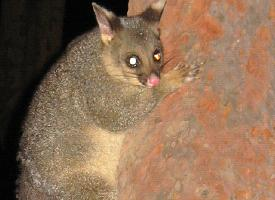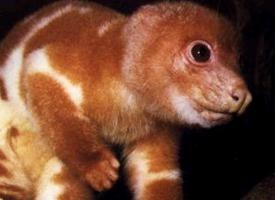
Weights and measures
| Length | from 35 to 55 cm |
|---|---|
| Weight | from 1,5 to 4,5 kg |
Biological data
| Lifespan | from 14 to 15 years |
|---|
Animal description
The Common Brushtail Possum (Trichosurus vulpecula) is a nocturnal marsupial native to Australia, and its presence has also been established in New Zealand where it was introduced in the 19th century. This species is one of the most widely recognized possums in Australia and plays a significant role in the ecological dynamics of its habitat. The Common Brushtail Possum exhibits a robust adaptability to various environments, thriving in both native bushlands and urban areas.Physically, the Common Brushtail Possum is noted for its thick, bushy tail from which it derives its name. The tail, partially prehensile, aids in gripping branches, thereby facilitating movement through the trees. This feature is critical for a species that spends a considerable amount of time in the arboreal realm. The fur of the Common Brushtail Possum is typically grey or brown, with variations ranging from silver-grey to black, depending on the geographical location. Their underbelly, however, is usually lighter, showcasing shades of cream or orange. They have large, pointed ears and a pronounced snout, with sharp, chisel-like teeth adapted for a varied diet.
In terms of size, the Common Brushtail Possum is relatively large compared to other possum species, with body lengths ranging from 32 to 58 centimeters (12.5 to 22.8 inches) and a tail length that can add an additional 24 to 40 centimeters (9.4 to 15.7 inches). They can weigh between 1.2 to 4.5 kilograms (2.6 to 9.9 pounds), with males generally being larger and heavier than females.
Dietarily, the Common Brushtail Possum is an omnivore with a preference for eucalyptus leaves, which constitutes a significant part of its diet. However, it has a flexible diet that also includes fruits, flowers, small insects, and even bird eggs. This adaptability in feeding habits is one of the reasons for its successful colonization of diverse environments, including urban areas where it is known to raid gardens and fruit trees.
Reproduction in the Common Brushtail Possum involves a gestation period of about 17 to 18 days, one of the shortest among mammals. Typically, a single joey is born, which then crawls into its mother's pouch for further development. The joey remains in the pouch for about five months, after which it begins to explore the outside world while still being nursed and carried on its mother's back until it is about seven to nine months old.
The interaction of the Common Brushtail Possum with humans has been mixed. In its native Australia, it is protected by conservation laws, but its adaptability has led it to be considered a pest in some urban areas, due to its tendency to inhabit roofs of houses and feed on garden plants and vegetables. In New Zealand, where it has no natural predators, it has been declared a pest due to its destructive impact on native forests and birdlife, leading to extensive control measures being implemented.
In conclusion, the Common Brushtail Possum is a fascinating marsupial with a complex relationship with its environment. Its ability to adapt to diverse habitats has ensured its survival but also brought it into conflict with human interests. Despite these challenges, the Common Brushtail Possum remains an integral part of the ecological communities of Australia and New Zealand, playing a role in the dispersal of seeds and acting as a prey species for larger predators.
Similar Animals
New photos of animals
Top 10 animals
- Dolphin gull (Leucophaeus scoresbii)
- Diana monkey (Cercopithecus diana)
- Moustached guenon (Cercopithecus cephus)
- Galápagos tortoise (Geochelone nigra complex)
- Japanese macaque (Macaca fuscata)
- Russian tortoise (Testudo horsfieldii)
- Stone loach (Barbatula barbatula)
- Greek tortoise (Testudo graeca)
- Common flying dragon (Draco volans)
- Vendace (Coregonus albula)

